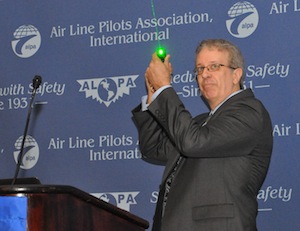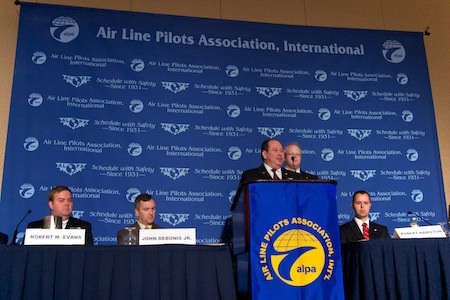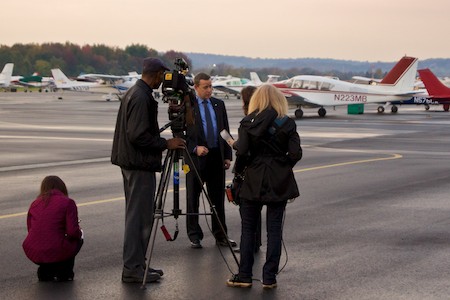Home
A comprehensive resource for safe and responsible laser use
US: ALPA holds major D.C. conference on the threat of laser illuminations
Speakers generally agreed on the nature and scope of lasers as a threat to air safety. They also offered similar solutions, including educating the public to not misuse lasers, prosecuting those who do, training pilots on how to "recognize and recover" from incidents, increasing the number of reports from pilots and the public, and restricting laser pointer availability.
The ALPA conference made news primarily for the announcement of a new FAA web page, which can be reached via www.faa.gov/go/laserinfo. FAA Administrator Randy Babbitt told the ALPA attendees that the web page -- erroneously described as a "website" in many media accounts -- would centralize the agency's information on laser/aviation safety. The page includes email addresses where pilots, air traffic control and the public can report laser incidents (see separate story about the FAA web page).
Babbitt also said that the FAA currently has filed 18 civil cases against individuals who aimed lasers at aircraft. There is a maximum $11,000 fine in each case.
Other speakers gave updates and information in their areas of expertise.
Legislation and regulation
Rep. Daniel Lungren (R-Calif. 3) discussed his bill H.R. 386, providing criminal penalties of up to five years for aiming at aircraft. He said although final passage through Congress is close, there is still work to be done: "The ball is on the 10 yard line and we've got to get it over."
The actual status of the bill is unclear. Some speakers indicated that the Senate version, S 1608 introduced by Sheldon Whitehouse (D-RI), had cleared the Senate Judiciary Committee and has been passed by the full Senate. If so, then H.R. 386 and S 1608 would be in conference committee to work out the minor differences between the two bills, before sending it to President Obama for his signature. However, online tracking of S 1608 shows that the bill has not yet passed the Senate Judiciary Committee. (S 223, an act to reauthorize FAA funding, also has an amendment with the Lungren language; this bill has been stalled in Congress and has not yet passed as well.)
During comments from the audience, Daniel Hewett and Robert Doyle of the Food and Drug Administration said that FDA will be issuing new rules on lasers in November or December of 2011. Hewett indicated that FDA is considering making manufacturers liable for misuse of their lasers. Doyle asked the audience to watch for publication of the proposed FDA rulemaking in the Federal Register, and to provide FDA with comments and suggestions.
ALPA proposals
ALPA President Captain Lee Moak discussed the association's proposals, first put forth in January 2011. They include passage of Lungren's bill, restrictions on lasers "strong enough to cause injury", improved pilot and air traffic control procedures, and adding laser safety to the National Transportation Safety Board's list of "Most Wanted Transportation Safety Improvements".
Laser effects and vision
One area where there was slight disagreement among participants involves the number of serious injuries to pilots. Various speakers gave numbers ranging from none ("no permanent injuries in any FAA incidents"), to "a few", to 37 injuries that were resolved. The disparity is likely due to differing definitions of eye effects and eye injuries. This may be an area where improved information gathering and category definitions would be useful.

Patrick Murphy demonstrates a 1 watt handheld laser
to the ALPA meeting attendees
LaserPointerSafety.com's Patrick Murphy, representing the International Laser Display Association, spoke on "The Science of Lasers". He used lasers, a flashlight and a camera flash to demonstrate distraction, glare and flashblindness effects to the attendees. He stressed that laser effects far away are different from effects close up, showing how a balloon located a few yards away could not be damaged by a 1 watt handheld laser, but at close range the laser easily made a hole in the rubber. He discussed why the general public misjudges laser effects and thus aims at aircraft. Finally, Murphy gave suggestions including consideration of a Laser Safety Tax as an alternative to bans or restrictions on lasers.
The dangers to vision were described in physics and medical terms by Dr. Quay Snyder, ALPA's Aeromedical Advisor. He told how the eye is 35 times more sensitive to green light than to red light, so green lasers are perceived as much brighter than red lasers of equal power. Snyder said that the injury potential of lasers depends on the light's irradiance (energy per unit area), the pupil size, focus, and whether the subject blinks and turns. The highest risk to pilots comes when the aircraft is slow (or hovering), close to the ground, has a predictable flight path, has a large windscreen or canopy, when the pilot is flying under Visual Flight Rules, and when there is intentional targeting of the aircraft (vs. a brief accidental exposure).
Snyder proposed protective measures including crew training using ALPA guidance and the Air Force/FAA training video, glare shields and light blockers, possible use of protective eyewear, public education, legislation, and enforcement. He said permanent effects are unlikely but temporary effects are a growing safety threat.
Pilot experiences

Captain Henry Cisneros speaks along with First Officer Drew Wilkens,
as the pilots address the ALPA laser illumination threat conference
held October 27 2011.
A number of pilots spoke about their experience with laser illuminations. Express Jet pilots Henry Cisneros and Drew Wilkens said that the effects are not just about bright light. They described physical effects such as eyes feeling warm (which they said may have been due to rubbing them), and emotional effects such as fear and anger.
Pilot Robert Hamilton of PSA Airlines said he had been hit twice by lasers, near Detroit in 2005, and at Charlotte Douglas Airport in September 2011. Fairfax County (Va.) officers John Debonis Jr. and Robert Evans said that police helicopter pilots investigating laser events now are forced to weigh the risk of being lased and possibly injured, against the reward of identifying a suspect.
Prosecution of laser cases
Supervisory Federal Air Marshall Timothy Childs of the Federal Bureau of Investigation described how the FBI has set up 15 laser strike working groups around the country. Each one is focused on a particular airport or area. The groups bring together local and federal prosecutors, police agencies, and representatives from FAA, FBI and other agencies. Groups set up procedures for investigating and prosecuting laser misuse. Childs said the working groups "run like clockwork" once they are set up, with coordinating meetings held about twice a year.
Childs feels the laser strike working group in Sacramento, California has helped lower the number of incidents. In 2008 there were 23 laser incidents near Sacramento International Airport. In 2009 and 2010, 21 persons were arrested and 19 of these were convicted. The number of laser incidents dropped in 2009 to 12, and there were only 6 incidents in 2010.
Childs said the FBI is seeing increasing incidents where lasers are used by criminals to distract pilots who are searching for suspects. In addition to being unsafe for pilots, this gives criminals a chance to get away.
He also noted that lasers are becoming more powerful. This year, they have seen more eye injuries than in all previous years.
The next speaker was Karen Escobar, Assistant U.S. Attorney for the Eastern District of California, which includes Sacramento. She discussed some of the problems prosecutors face in laser cases. She said that while there are stiffer penalties at the federal level, it can be easier to establish proof if a case is brought under state law. Specifically, the intent portion of 18 USC 32 is a "difficult hurdle".
Escobar said that about half of perpetrators receive jail terms, while the other half are put on probation. Jail is usually reserved for persons with a "criminal history of reckless disregard for human life."
While she appreciates the Lungren bill, she would like to see stronger penalties. HR 386 provides a five year maximum jail sentence. Escobar said that a 20-year sentence is a much better plea bargaining tool.
The international view
The ALPA conference concluded with a panel of international safety experts.
Don Wykoff of the International Federation of Air Line Pilots' Associations called "a laser attack is a deliberate, premeditated attack" and needs to be treated as such by society. One education tactic he mentioned was putting posters in jetways and at airports, to tell the public this is unsafe and illegal and to urge reporting of any incidents.
Ken Dunlop of the International Air Transport Association said one clear theme of the conference is that "we need more reporting from pilots."
Captain Jo Schoenmaker of the European Cockpit Association proposed that it may be time to reexamine the notion that blinking can help protect against laser injury and bright light effects: "In laser tests with real people, only 25% actually blinked."
Constable Jeffrey Sharp of the Peel Regional Police in Ontario described how Health Canada has started seizing high powered lasers including the blue 1 watt Wicked Lasers Arctic Spyder. Seizure occurs under a provision of the Radiation Emitting Devices Act since the laser is "far more powerful than necessary to accomplish its purpose."
Sharp also told of a new Canadian law, the Consumer Product Safety Act, passed June 2011. This makes it easier to protect the public from products that have "foreseeable misuse." He implied that laser pointers and handheld lasers could be included due to misuse against aircraft.
The final speaker, Inspector Mark Callaghan of the Sussex Police, also came the farthest to address the conference. He told how U.K. incidents have risen from 24 in 2007, to 1786 in 2010 and are currently (Sept. 30 2011) at 1800. He said analyses have shown that the type of housing under airport approach paths, and the demographic makeup of the housing residents, is a factor in a number of incident reports. Callaghan believes sales of lasers over 1 milliwatt should be regulated.
Summary
The moderator, Captain Sean Cassidy of ALPA, then closed the conference by noting the agreement of so many of the speakers on the major points of this issue, and the need to continue action in areas such as education, legislation, enforcement, training and regulation.

Sean Cassidy, ALPA’s First Vice President and National Safety Coordinator, talks to ABC News’ Lisa Stark at Leesburg (Va.) Executive Airport. Stark and her crew filmed on October 26, the evening before the ALPA conference. After darkness fell, a camera was set up in a parked aircraft in order to show the effect of a 100 mW green laser aimed from 1150 feet away. The footage was not used as of October 30, but Stark did write a blog based on her interviews during the shoot.
Conference sponsors
Outside the conference, three sponsors demonstrated their eye protection products for pilots: NoiR Laser Shields, Honeywell Sperian, and Night Flight Concepts. NFC introduced Laser Armor products including anti-laser glasses for pilots, anti-laser filters for night vision goggles, the online course “Laser Defense Training”, and laser defense consulting.
News coverage
Most news coverage mentioning the ALPA conference was focused only on the FAA announcement. There were a few stories that discussed other aspects as well:
- ABC News
- Aviation International News
- USA Today (pre-conference and post-conference)